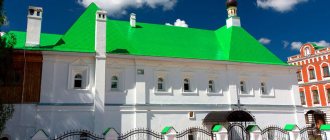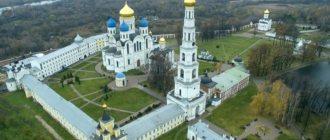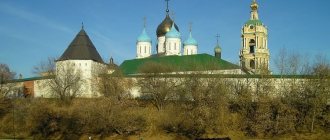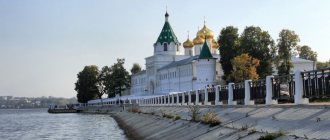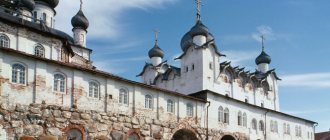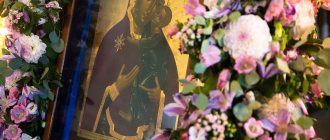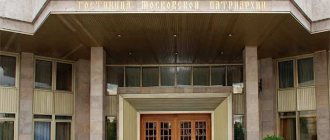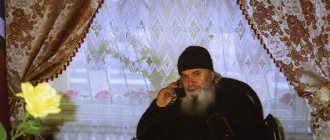Spaso-Preobrazhensky Monastery in the city of Murom. Now it is with great pleasure that I will tell you about this holy monastery, which we fell in love with with all our hearts during the 2 days we spent on its territory in the pilgrimage hotel.
I would like to note that in Murom there are 4 monasteries and many churches. Of course, the most popular among numerous tourists and pilgrims is the Holy Trinity Women's Monastery, which houses the relics of the holy noble princes Peter and Fevronia. Visiting this place gives an extraordinary feeling. But the impression from the male Spaso-Preobrazhensky Monastery was no less, but the most positive and surprising.
Currently, on the territory of the monastery there are 2 large churches, a sacristy, a bell tower, a bathhouse, chapels, a fraternal building, a pilgrimage hotel and a refectory, and an educational building. All this is located on a very well-kept area. You can read more about the history of the monastery, its churches and shrines here.
We were very pleased that we stayed here, at the Spaso-Preobrazhensky Monastery. We had a lot of time to calmly wander along its cozy paths, visit all the churches, touch its many shrines, breathe the incomparable monastery air, mixed with the watery freshness of the Oka and the smells of bread from the local bakery.
Origin of the name and its meaning
The Transfiguration Monastery in the city of Murom originates from the wooden Church of the All-Merciful Savior, built by Prince Gleb after receiving the Murom land into his possession.
The Spasskaya Church became the first Orthodox building in the then pagan city. Despite the fact that the construction of the church was necessary for the personal needs of the Grand Duke, later a whole monastery arose around the church, located in the princely courtyard, called “Spassky, on the Forest” in common parlance. Due to its location in a wooded area on the banks of the picturesque Oka River, this name was given to the monastery.
After the Transfiguration Cathedral was erected in 1555, which became the first large stone building, the monastery began to be called “Spaso-Preobrazhensky”.
In Church Slavonic, the word “Savior” is an abbreviated name for the Savior, the Lord Jesus Christ, and the assignment of such a name means that a temple, cathedral or other religious building is consecrated in honor of Christ the Savior. The addition of the word “Transfiguration” to the name symbolizes that the temple is dedicated to the important feast of the Transfiguration of the Lord in Orthodoxy.
Feast of the Icon of the Quick Hearer of Mother's Tears
On November 22, and according to the old style on November 9, all Orthodox Christians pay tribute to the memory of the holy face. Divine services are held in all churches; the rectors tell their parishioners about miracles that happened to those who turned to the Mother of God for help.
It is believed that on this day prayer has special power. The holiday has its second name due to the fact that it is mothers who in most cases go to ask for their children and ask for them with tears.
If it is not possible to visit the temple on this special day, you can read a prayer at home, best in your own words, sincerely repenting and believing for indispensable help.
History of the Spaso-Preobrazhensky Monastery
According to the chronicles “The Tale of the Establishment of Christianity in Murom”, it is generally accepted that the monastery was founded no later than 1015. The manuscript tells that the establishment of the monastery can be associated with the name of the Holy Prince Gleb, the passion-bearer, who was the son of Prince Vladimir, who baptized Rus'.
Having inherited the Murom inheritance, the Orthodox passion-bearer Prince Gleb began his reign there and tried to preach Christianity among the local pagan population.
His first attempt was not successful, so he had to organize his princely court outside Murom. By order of the prince, the city’s first wooden church of the “All-Merciful Savior” was erected on the territory of his possessions, from which the “Monastery of the Savior on the Forest” later grew.
A specific footnote to the Spassky Monastery and its life is found in the document “Monastery of the Savior on the Bor” and dates back to 1096.
Little is known about the monastery during the invasion of the Mongol Tatars: in 1238 the entire city, including the Spasskaya Monastery, was burned. Later, in 1351, Prince Yuri Yaroslavovich took up the revival of the Murom lands: he rebuilt city buildings, restored churches, which he filled with liturgical utensils. The restoration affected not only civil buildings, but also spiritual objects.
The Spaso-Preobrazhensky Monastery (Murom) experienced a period of prosperity during the reign of Ivan the Terrible. Before the campaign against the Kazan Khanate, in 1552, the king visited the monastery and undertook to build a stone cathedral there after the capture of Kazan. Having won the victory, Ivan IV kept his promise and erected not only a temple there, but also presented other rich gifts.
In 1555, with the help of royal craftsmen, the Transfiguration Cathedral was erected from stone on the site of the former wooden Spassky Church, and liturgical utensils, holy images, books and priestly vestments were donated by the sovereign himself. Also, according to his decree, the charter of the monastery became “coenobitic”, and the territorial possessions were supplemented with new lands.
Murom suffered an invasion of armed Lithuanian hordes in 1616, as a result of which the main stronghold of faith, the Transfiguration Monastery, also suffered. During the time of the church schism (closer to the middle of the 18th century), the current rector was removed from service at the Spassky monastery due to his adherence to the Old Believers.
At the end of the century, another object was added to the monastery ensemble - the winter stone Intercession Refectory Church, on the lower tier of which utility rooms were located.
Around the same time, another stone church named after St. Kirill of Belozersky was built. Towards the end of the 17th century, thanks to generous donations, the two-story abbot's chambers were built and the reconstruction of the then damaged Intercession Refectory Church began.
The 18th century was marked by several events: the creation of a theological school for the education of children of clergy, as well as the transfer of all the brethren of the abolished Boris and Gleb Monastery to the Spassky Monastery. The policy of Catherine the Great did not have the best impact on the life of the monastery: part of the monastery possessions was treacherously confiscated.
In 1878, the icon of the Mother of God “Quick to Hear” arrived from the Panteleimon Monastery of Mount Athos, which later became one of the most famous icons of the monastery. Thanks to the further restoration and acquisition of the shrine, more and more pilgrims flowed to the Spassky Monastery, which was becoming famous throughout Russia.
In 1891, a new building appeared in the monastery, intended to house the monastic brethren.
Due to accusations of anti-Soviet propaganda, after the outbreak of the 1917 revolution, the monastery was closed, and the property was partially looted or transported to the Murom Museum. Almost 10 years later, the Red Ray textile factory was located in the monastery. In 1929, the military department invaded the monastery, and public access to shrines and temples was completely prohibited.
Only in 1995, thanks to the appeal of Professor Dmitry Likhachev and the public to His Holiness Patriarch Alexy II, it was decided to evict the military unit. Thanks to the diligence of the future abbot, monk Kirill (Epifanov), the Transfiguration Monastery opened its doors to believers in the same year.
Spaso-Preobrazhensky Monastery (Murom) during restoration
The damage caused by the anti-church authorities seemed significant, so it took 10 years to restore the monastery . During this time, communications were restored, old buildings were restored and new chapels and temples were founded.
Peter and Fevronia of Murom
On the square near the monasteries there is a Monument to Peter and Fevronia of Murom , patrons of love and marriage. We have already written about the life and death of these saints, as well as the history of the “Day of Family, Love and Fidelity,” which is celebrated on July 8, in the post “The Feast of Peter and Fevronia: History and Traditions.” But how their relics ended up in the Holy Trinity Monastery should be told separately.
Initially, the relics of the faithful Prince Peter and Princess Fevronia rested in the Cathedral of the Nativity of the Blessed Virgin Mary , built over their relics by Tsar Ivan the Terrible in 1553. The relics of the saints were in a cypress shrine, made later, in 1797, in the chapel of the Supreme Apostles Peter and Paul. Next to the cathedral stood the wooden church of the blessed Peter and Fevronia, which was dismantled at the end of the 18th century to make room for the bell tower. The cathedral, according to descriptions, was distinguished by its beauty and wealth.
After the revolution, the Nativity of the Mother of God Cathedral, like most other churches in Russia, was looted, and some of the church utensils were transported to the local history museum. The relics of Peter and Fevronia were also transported there in 1921 and put on public display. In 1924, the cathedral was closed, and in 1934 it was transferred to the military department. In 1939, the walls of the cathedral were dismantled, the bell tower stood a little longer, because it was used as a fire tower. However, then she was destroyed too. Nowadays on the site of the cathedral there is Oka Park.
Murom, Cathedral of the Nativity of the Virgin Mary, photo from the late 19th century (from Wikipedia)
On September 19, 1992, the relics of the holy faithful Prince Peter and Princess Fevronia were transported to the Trinity Cathedral of the Holy Trinity Convent. And today people come here with prayers for love and marriage.
Current status of the Spaso-Preobrazhensky Monastery
The Spaso-Preobrazhensky Monastery (Murom) is currently operational, and its territory and facilities have been completely restored after the Soviet period.
The revival of the monastery occurred thanks to the creation of a board of trustees and further financial assistance from Interros Investment Company, Gazprom PJSC, RIK-WEST Investment Company, SUEK Group, Metropol IFC, as well as donations from capital and St. Petersburg entrepreneurs.
The monastery has retained a communal charter, which provides for the monks to live together in the Spassky Monastery, as well as to conduct economic activities.
Since 2013, the Transfiguration Monastery (Murom) has become the general administrative center of the newly created Murom diocese. At the moment, the abbot of the monastery is Nil (Sychev), Bishop of Murom and Vyaznikovsky.
Interesting facts and legends
- According to various sources, it was on the territory of the monastery that the baptism of the Murom pagans took place.
- The Spaso-Preobrazhensky Monastery (Murom) is the second oldest after the Kiev-Pechora Lavra and has a history of almost a thousand years.
- The names of the holy spouses Peter and Fevronya are inextricably linked with the life of the Spassky monastery. The holy prince was tonsured a monk in this monastery. He died there. This event is marked by a monument to the holy princes and hagiographic frescoes.
Vladimir Icon of the Mother of God
The list “Miracle-Working Icons of Russia” cannot be imagined without the indicated face. The history of the image to this day is full of secrets and mysteries. The appearance of the face in Rus' is also hidden under the veil of secrecy. There are various legends in chronicles and legends about how the Icon of the Mother of God came to the territory of the state. A photo of the face can be seen further in the article, and the original is kept in the Assumption Cathedral, which is located in Vladimir.
It was this fact that became the reason for the name of the face - Vladimirskaya. In all centuries, kings, princes, clergy and the modern worldly population pray to the miraculous icons of Russia, including the image of the Mother of God, asking to be saved from war, schism, disease, fires and robberies.
Shrines of the Spaso-Preobrazhensky Monastery
- One of the most famous and especially revered shrines of the Spaso-Preobrazhensky Monastery by Orthodox people is the icon of the Mother of God “Quick to Hear.” She appeared in Murom towards the end of the 19th century and immediately became an indispensable assistant in the difficulties of the brethren of the monastery and all Murom residents. The icon was donated by the monks of the monastery of St. Panteleimon of Holy Mount Athos and is an exact copy of the miraculous image of the Mother of God of the same name, kept in the Dochiar monastery on Mount Athos. The icon is located in the Church of the Intercession, access to it is open during the opening hours of the monastery, you can leave fresh flowers near it and pray for your needs.
- Another “Athos” shrine, the icon of the Mother of God Pantanassa, resides in the Spassky monastery. Pantanassa, or in other words the All-Tsarina, was written and consecrated on Mount Athos in the Vatopedi monastery. It is believed that cancer patients who pray to this icon receive healing from their illnesses.
- Everyone can also venerate the Monk Elijah of Pechersk: a particle of the preserved relics, donated from the Holy Dormition Kiev Pechersk Lavra, is located in the left “right hand” (hand) of the statue of the holy saint, made of wood. The sculpture was created in 2006 according to the height and appearance parameters obtained as a result of scientific research of the preserved relics of the hero Ilia Muromets.
- In the chapel of the holy warrior George the Victorious there is an icon of the great martyr depicting scenes from his life. The reliquary with the particle is on the bottom of the icon.
- The image of the holy physician, Archbishop Luke (Voino-Yasenetsky) with a particle of his relics is in the same church. The canonization of Saint Luke occurred relatively recently: in 2000.
- There you can also pray to the holy spouses Peter and Fevronya in front of their icon and the ark with a particle of relics enclosed and ask for help in family matters.
- The icon of the Romanov royal family contains a stone taken from the wall of the Ipatiev house, where the Royal Passion-Bearers were brutally shot. The shrine can also be found in the Intercession Cathedral. Ensemble of the Spaso-Preobrazhensky Monastery.
What do they pray to the icon for?
People turn to the image of the Quick Hearing icon during any difficulties in life, when instant help is needed.
People go to the icon for help in case of frequent depression, panic attacks, causeless anxiety and fear. Often the very first prayer helps to strengthen one’s spirit and cope with one’s fears.
The icon helps people suffering from blindness or deafness.
Women ask for a safe resolution to a difficult birth, as well as for a successful outcome of a long-awaited pregnancy.
Cancer patients and their loved ones turn to the miraculous image and receive favorable results.
People who have sinned a lot and live in sin ask the Mother of God for forgiveness and help.
All people who sincerely believe receive God's quick help after praying, repenting and beginning spiritual life.
Ensemble of the Spaso-Preobrazhensky Monastery
At the moment, the Spassky Monastery includes: 2 cathedrals, 4 churches, 6 chapels, fraternal and abbot's buildings, a bakery, an educational building, and a pilgrimage hotel. Despite the long and not always simple life of the monastery, its historical appearance was preserved. The buildings are made mainly of white stone, but there are also buildings made of red stone.
Cathedral of the Transfiguration
The Transfiguration Cathedral is the oldest monastery building, erected in 1555 by order of Ivan the Terrible. Despite numerous transformations, the cathedral has retained its original appearance.
The cross-domed monolithic temple is made of white stone and is topped with five black onion domes (one large central dome and four smaller domes) with openwork gold crosses resting on four pillars.
Since the cathedral could previously be used as a fortress and refuge during military raids, its architecture is distinguished by its severity. The simplicity of construction is confirmed by the absence of any interior decor. The cathedral houses parts of about 30 saints of the Orthodox Church.
Church of the Intercession of the Blessed Virgin Mary
In 1691, the white stone two-story Intercession Cathedral was erected with the financial participation of Metropolitan Barsanuphius. The cathedral is divided into upper and lower churches, which are still in use today. Later, a three-tiered hipped bell tower was added to the West side and a bell was donated. The church contains many highly revered shrines and several altars.
Church of Kirill Belozersky
The gate church of St. Kirill Belozersky was founded in the 10th century. Initially, the location of the building was different, but as a result of numerous reconstructions and rebuildings, the church was abolished, and only in 2005 it was possible to restore it.
All this time, the very first altar of the church was in the Intercession Cathedral, and by the time of consecration it was transferred to the new church of St. Cyril.
Church of St. Sergius of Radonezh
Another gate church is located on the opposite side of the monastery. The church of the “abbot of the Russian land” Sergius of Radonezh, also consecrated in 2005, has its own bell tower, where anyone can try out the ancient “bil” system.
The ringing is made not with the help of bells, but by hitting rectangular copper plates with “beaters”, which in appearance resemble hammers. The icon of Sergius of Radonezh, consecrated on the relics in the Trinity-Sergius Lavra, is located in this church.
Chapel on the site of a former cemetery
The chapel-ossuary is located on the site of a once-existing monastery cemetery, where princes, church employees, and noble citizens were previously buried. The cemetery was desecrated in the difficult years for the entire country in the 1930s, when an entire military unit arrived at the monastery and occupied its buildings and territory.
During the restoration of the territory, the ashes of people who were once buried here were excavated. For the purpose of burial, it was decided to create a chapel according to the custom adopted on Mount Athos.
Chapel of the Icon of the Mother of God “Life-Giving Spring”
The monastery chapel “Life-Giving Spring” is equipped with a font.
You can take water from the source with you, as well as plunge into the cool, blessed water. In the bathhouse there is a stone brought from Israel, from the Jordan River.
Chapel of St. George the Victorious
In 2005, another small chapel was consecrated in honor of Russian soldiers killed on the battlefield. St. George the Victorious became her patron saint.
In the chapel there is an icon of the great martyr with a particle of his relics.
Rectoral and fraternal buildings, house churches
The abbot's chambers are a two-story white stone building. This is the oldest surviving stone civil structure in Murom. The exterior of the building is a rectangular building with triangular pediments above the windows, and is characterized by simplicity and modesty.
There were storage rooms on the lower floor, and cells on the second floor. A church was also organized in the rector's house in honor of St. Basil, Bishop of Ryazan.
The building, intended for the life of the monks of the monastery, was originally wooden, but at the end of the 19th century, as a result of transformations, another floor was added, and the building itself became stone. Later a house church was opened here.
Chapel of St. Nicholas the Wonderworker and Elijah the Prophet
The Nikolo-Ilinskaya Chapel was established in the corner tower on the western side of the monastery in 1889. Reopened in 2001.
The architecture of the chapel differs from the general monastery style: it is made of red brick and has many white decorative elements. The building is crowned not with a tent, but not with a dome, as would be customary within a monastery ensemble.
Other buildings
The monastic bread of the Spasskaya monastery is known throughout Murom. The bakery employs about 30 people, supplying bakery products to various retail outlets and shops in Murom. The cozy hotel can accommodate everyone: the pilgrimage center offers various categories of rooms, as well as inexpensive meals.
Texts of strong prayers
The miraculous power of the icon is manifested in the fact that all prayer appeals to the Mother of God “Quick to Hear” have great power.
Troparion
Let us now fall to the Mother of God as a father figure in troubles, and to Her holy icon, calling with faith from the depths of our souls: soon hear our prayer, O Virgin, who was called Quick to Hear, For for the sake of Your servants, a ready helper in need, the Imams.
About healing
When they ask for their health, they read the prayer:
“Oh, Most Holy Virgin, Mother of the Lord Most High, Quick to Hear the Intercessor of all who come running to You with faith!
Look down from the heights of Your heavenly majesty upon me, who is indecent, falling before Your icon, and quickly hear the humble prayer of the sinner me and bring it to Your Son:
beg Him to illuminate my gloomy soul with the light of His Divine grace and cleanse my mind from vain thoughts, to calm my suffering heart and heal its wounds,
may He enlighten me to do good deeds and strengthen me to work for Him with fear, may He forgive all the evil I have done, may He deliver me from eternal torment and may I not deprive Him of His heavenly Kingdom.
O Most Blessed Mother of God:
You deigned to be named in Your image, Quick to Hear, commanding everyone to come to You with faith:
Do not look upon me who is sorrowful and do not allow me to perish in the abyss of my sins.
According to God, all my hope and hope of salvation is in You, and I entrust myself to Your protection and intercession forever.”
About help
Most blessed Lady, Ever-Virgin Mother of God, who gave birth to God the Word more than any word for our salvation, and who received His grace more abundantly than all others, who appeared as a sea of Divine gifts and miracles, an ever-flowing river, pouring out goodness to all who come running to You with faith! To Your miraculous image, we pray to You, the all-generous Mother of the humane-loving Lord: surprise us with Your rich mercies and our petitions brought to You, Quick to Hear, speed up the fulfillment of everything that is arranged for the benefit of consolation and salvation for everyone. Visit, O Blessing Thy servants, with Thy grace, grant to the sick healing and perfect health, to those overwhelmed by silence, to those captivated by freedom, and to the afflicted by various images of comfort. Deliver, O All-Merciful Lady, every city and country from famine, plague, cowardice, flood, fire, sword and other temporary and eternal punishments, by Your maternal boldness turning away the wrath of God; and spiritual relaxation, overwhelm by passions and falls, free Thy servant, as if, without stumbling in all piety, having lived in this world, and in the future of eternal blessings, we may be made worthy of the grace and love for mankind of Thy Son and God, to Him belongs all glory, honor and worship with His Beginning Father and By the Most Holy Spirit, now and ever and unto ages of ages. Amen.
About marriage
O most holy Virgin, Mother of the Lord on High, quick to obey intercessor of all who come running to You with faith! Look down from the height of Thy heavenly majesty upon me, the indecent one, falling before Thy holy icon, quickly hear the humble prayer of me, a sinner, and bring it to Thy Son, beg Him to illuminate my dark soul with the light of the Divine grace of His grace and cleanse my mind from thoughts vain things, may he pacify my suffering heart and heal its wounds, may he enlighten me to good deeds and strengthen me to work for Him with fear, may he forgive all the evil I have done, may he deliver me from eternal torment and not deprive me of His heavenly kingdom. O most blessed Mother of God! You have deigned to be named in Your image, Quick to Hear, commanding everyone to come to You with faith, do not despise me, the sorrowful, and do not allow me to perish in the abyss of my sins, in You, through God, all my hope and hope of salvation, and Your protection and intercession I entrust it to myself forever and ever. Amen.
About assistance during childbirth
Most blessed Lady, Ever-Virgin Mother of God, who gave birth to God the Word more than any word for our salvation, and who received His grace more abundantly than all others, who appeared as a sea of Divine gifts and miracles, an ever-flowing river, pouring out goodness to all who come running to You with faith!
To Your miraculous image, we pray to You, the all-generous Mother of the Humanity-loving Lord: surprise us with Your rich mercies, and speed up the fulfillment of our petitions brought to You, Quick to Hear, all that are arranged for the benefit of consolation and salvation for everyone.
Visit, O Blessing Thy servants, with Thy grace, grant to those who are ill, healing and perfect health, to those overwhelmed by silence, to those in captivity, freedom and various images of the afflicted to console, deliver, O all-merciful Lady, every city and country from famine, plague, cowardice, flood, fire, sword and other temporary and eternal punishments, by Your maternal boldness turning away the wrath of God: and from mental relaxation, overwhelming passions and falls, free Your servants, so that without stumbling in all piety, having lived in this world, and in the future, eternal blessings, we will be honored with the grace and love of mankind of Your Son and God, Him. befits all glory, honor and worship, with His Beginning Father and the Most Holy Spirit, now and ever, and unto ages of ages. Amen.
To fulfill a wish
Oh, Most Holy Virgin Mary, Mother of the Most High Lord, Quickly Hearing Helper and Intercessor of all who come running to you with requests. Cast your gaze upon me from the height of your heavenly greatness and hear my spiritual request. Bring to your Son, our God, a prayer for me, a sinful and unworthy servant of God (proper name). Clear my mind from vain thoughts and help my desire come true (you need to voice your desire in detail). Help me calm my suffering heart and heal my spiritual wounds. I accept the will of our Lord and glorify His Holy Name. Amen.
To get pregnant
Oh, Most Holy Theotokos, Mother of our Lord, I ask you to hear the prayer of the servant of God (proper name) and help me. Ask Your Son, our Lord Jesus Christ, to cleanse my mind from vain thoughts and illuminate my soul with joyful hope. Strengthen, Most Holy Theotokos, my will and give me strength to accept the will of God. May the Almighty forgive my voluntary and involuntary sins. Help me, Most Holy Theotokos, in a successful childbirth, do not let me live a meaningless life, let me know the happiness of motherhood. Amen.
Address, how to get to the monastery
Address of the monastery: Vladimir region, Murom, st. Lakina, 1.
| Point of departure | Directions description | Approximate travel time |
| Kursky railway station, Moscow | By intercity bus it takes about 3.5 hours to get to the bus station in the city of Vladimir. Next, transfer to a minibus or bus to the city of Murom, the ride takes about 2.5 hours. | 6 hours |
| Shchelkovskaya metro station (Arbatsko-Pokrovskaya line) | From the Shchelkovo bus station take the intercity bus Moscow - Murom for about 4 hours | 4.5 hours |
| By car | Follow the Gorkovskaya (Nizhny Novgorod) highway M7 to the city of Vladimir. Before Vladimir, turn right onto Murom (follow the sign before entering the city). | 4 hours |
Schedule of services
| Day of the week | Divine service | Time |
| Monday-Saturday | Watch. Divine Liturgy. | 07:40 |
| Vespers. Matins. | 17:30 | |
| Sunday | Watch. Early Divine Liturgy. | 08:00 |
| Watch. Late Divine Liturgy. | 10:00 | |
| Vespers. Matins. | 17:30 |
Opening hours: from 07:30 to 20:00 for pilgrims and from 10:00 to 17:00 for tourists. Each milestone of the eventful thousand-year history left its mark on the life, way of life and way of life of the monastery.
Having survived various historical eras favorable and destructive for the faith, the Transfiguration Monastery survived, maintaining its uniqueness and replenishing its spiritual and material fund with new shrines and important historical events, remaining one of the most important spiritual centers of the city of Murom.
Author: Rozova Tatyana
Article design: Vladimir the Great

